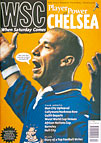 Manchester United are the team of the 1990s but don't have an independent magazine. Paul Windridge reveals how his attempts to change this were blocked
Manchester United are the team of the 1990s but don't have an independent magazine. Paul Windridge reveals how his attempts to change this were blocked
We all realise that to win at football you will probably need a bit of luck along the way. But when you play the game, there is a certain equality of opportunity – two teams of 11 players each, changing ends at half-time etc. – in short, a level playing field. Does that hold true for the business of football too? I think you can guess the answer.
A year or so ago I suggested to my partner that we should consider the possibility of producing a monthly magazine about Manchester United. I have been a supporter and regular match-goer for longer than I care to remember, so at least the emotional commitment would be there. Our reasoning was that United have the biggest following, the team of the Nineties and a hugely successful marketing machine. What they didn’t have was a national magazine on the newsagents’ shelves, produced independently by supporters who actually go to the games and support the team week in, week out. So United by Football was born.
The content of the magazine evolved over the months to become a mix of player profiles, match reports, flashbacks and features but the common thread was that it was entirely written by supporters. We had no need for player interviews or access to club personnel, not that we would have been granted any, because the intent was to produce a magazine by and for fans.
We had the likes of Pat Crerand and Tom Tyrell of Piccadilly Radio on board who were our link to the day-to-day machinations at the club. The feedback we received from within the confines of the club was good. Tom Tyrell’s insight into Brian Kidd, for instance, was met with an extremely favourable reaction from the man himself. Our intent at all times was to be constructive, not destructive.
We encountered a multitude of problems which would have thrown less committed souls off the track. Sure, we managed to find a distributor which would link us to the retailers, but a few months’ experience taught us that the system is loaded against independent publishers.
The magazine distribution game is a difficult one to fathom. Ten weeks elapse before you find out how your first magazine has sold; if mistakes have been made, they have already been repeated in the second issue, and are about to contaminate the third. It is not ideal by any stretch of the imagination and scarcely credible in this high-speed computer age. Moreover, if you suspect your distributor isn’t doing a good job, by the time you get any evidence, permanent damage has almost certainly been done. You still assume you are playing on a level playing field, but at UbF we felt we were playing up one of those infamous slopes in a blizzard.
Questions that arose included: Why didn’t UbF appear on the shelves of WH Smith? Why did we receive countless phone calls, e-mails and letters from people who knew the magazine was out there, but couldn’t find it in any of their local shops? Why did competitors seem to know what we were doing almost before we knew ourselves?
We believed hostile forces were at work and the feedback from supportive insiders seemed to confirm that our every move was being hampered.
Another problem was the apparent impossibility of acquiring the quality up-to-date photographs that are absolutely vital to a visual monthly. Newspapers, magazines, agencies and individual photographers are supposed to sign the Premier League agreement which allows them to apply for accreditation to take photographs inside grounds. After signing this contract the photographer, agency or newspaper is not permitted to sell any of the photographs to any independent club-specific publication, even if no-one else wants them.
Does this smack of cartels, restraints of trade, even monopolies? It did to us. The Premier League feel they have a “product” which should be owned solely by them. But, providing there is nothing defamatory involved, shouldn’t a group of supporters be allowed to produce a magazine for fellow supporters and be allowed to purchase relevant photographs? Or is this a way for the football establishment to marginalise voices that might question the dominance of their clubs by plcs?
Ultimately, we found ourselves in an impossible position and were left with no other choice but to pack it in. The football industry, with its anti-competitive policies, was strangling us quite openly. Maybe we’ll find out who was lurking behind our backs but that will be no consolation to the readers who enjoyed our magazine as an independent alternative to the official mouthpiece. To those who try to follow in our path, good luck – you’re going to need it.
From WSC 134 April 1998. What was happening this month